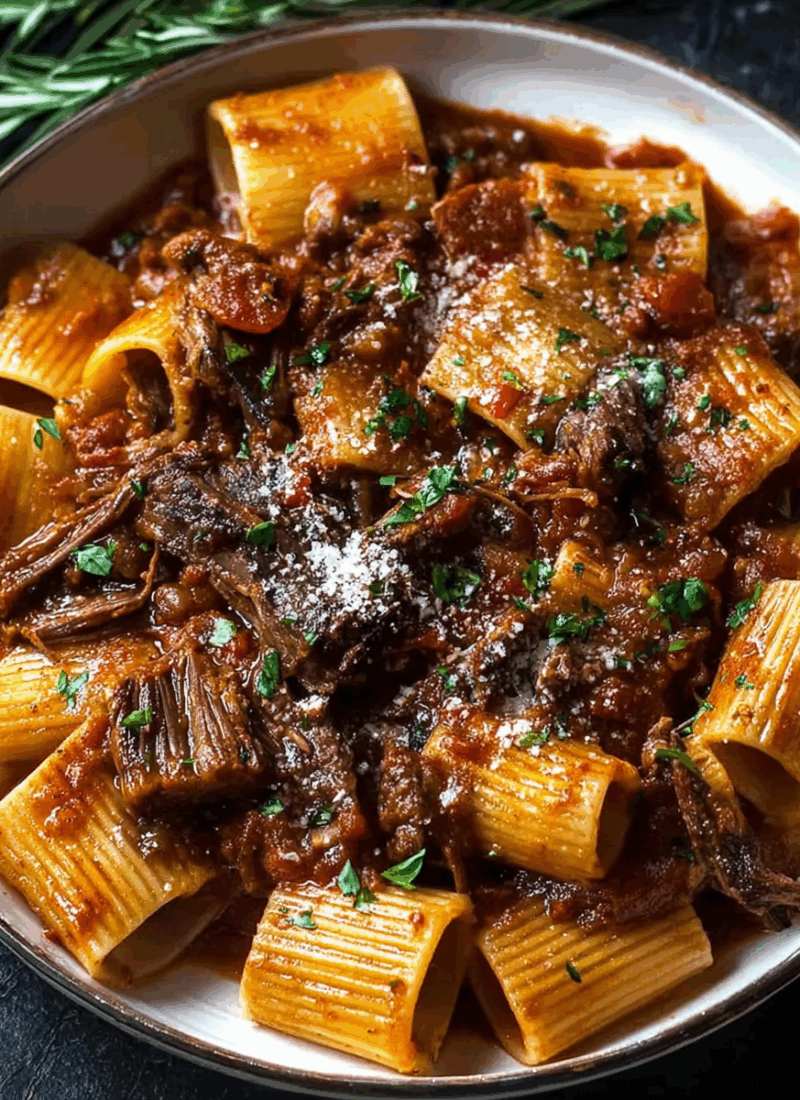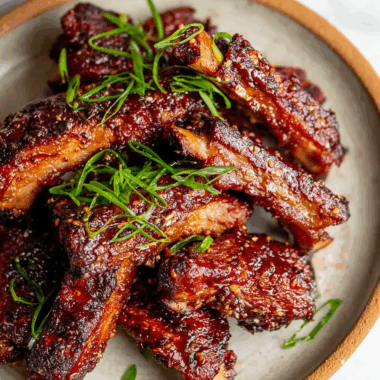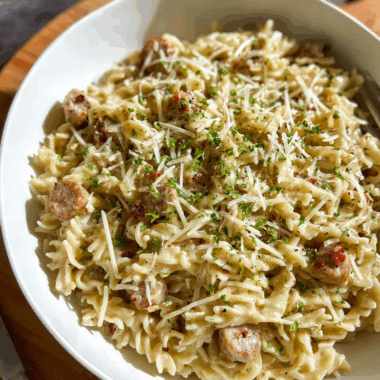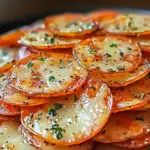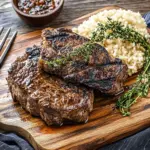Braised Short Rib Ragu Pasta is a comforting and rich Italian classic. The slow-braised beef becomes meltingly tender, creating a hearty sauce that perfectly coats pasta. With its deep flavors, this dish is perfect for cozy family dinners or impressive gatherings. The braising process makes the short ribs incredibly tender, while the combination of aromatic vegetables, red wine, and crushed tomatoes adds a depth of flavor that is both savory and satisfying.
Full Recipe:
Ingredients
-
2 pounds beef short ribs
-
2 tablespoons olive oil
-
1 large onion, diced
-
2 carrots, diced
-
2 celery stalks, diced
-
4 cloves garlic, minced
-
1 cup red wine (preferably Chianti)
-
1 can (28 ounces) crushed tomatoes
-
2 cups beef broth
-
2 tablespoons tomato paste
-
2 teaspoons dried oregano
-
1 teaspoon dried thyme
-
1 bay leaf
-
Salt and pepper to taste
-
1 pound pasta (such as pappardelle or tagliatelle)
-
Fresh parsley, for garnish
-
Grated Parmesan cheese, for serving
Directions
-
Brown the Short Ribs:
Heat olive oil in a large Dutch oven over medium-high heat. Season the short ribs generously with salt and pepper. Brown them on all sides, about 3-4 minutes per side. Remove from the pot and set aside. -
Sauté Vegetables:
In the same pot, add diced onion, carrots, and celery. Sauté for 5-7 minutes until soft. Add minced garlic and cook for an additional minute. -
Deglaze with Wine:
Pour in the red wine, using a wooden spoon to scrape up any browned bits from the bottom of the pot. Let it simmer for 5-7 minutes to reduce slightly. -
Build the Ragu Base:
Stir in the crushed tomatoes, beef broth, tomato paste, dried oregano, thyme, and bay leaf. Return the browned short ribs to the pot. -
Braise the Ribs:
Bring the mixture to a gentle simmer, cover the pot, and reduce the heat to low. Let it braise for 2.5 to 3 hours, or until the meat is tender and falls off the bone. -
Prepare the Pasta:
About 15 minutes before the ragu is ready, bring a large pot of salted water to a boil. Cook the pasta according to the package instructions until al dente. Reserve 1 cup of pasta water before draining. -
Combine Pasta and Ragu:
Remove the short ribs from the pot, shred the meat, and discard the bones. Return the shredded meat to the sauce and stir well. If the sauce is too thick, add reserved pasta water gradually until the desired consistency is reached. -
Serve:
Mix the cooked pasta with the ragu until well coated. Adjust seasoning with more salt and pepper if needed. -
Garnish and Enjoy:
Serve topped with fresh parsley and grated Parmesan cheese.
Nutrients (Per Serving)
-
Calories: 600 kcal
-
Fat: 25g
-
Protein: 45g
The Magic of Braising Short Ribs
The key to a truly flavorful ragu lies in the braising of the short ribs. Braising is a slow-cooking technique that allows the meat to cook in a flavorful liquid, breaking down the tough fibers in the beef and transforming it into a tender, melt-in-your-mouth texture. The short ribs are browned to create a rich crust, which adds depth to the overall flavor, and then they are simmered for hours in a mixture of red wine, beef broth, and crushed tomatoes. This slow cooking method allows the beef to absorb all the flavors from the sauce, resulting in a tender and flavorful ragu that coats the pasta perfectly.
Braising also gives the meat a chance to release its rich juices, creating a luxurious, hearty sauce. The long, slow simmering allows the flavors to meld together, creating a depth that is both savory and satisfying. The result is a sauce that has layers of flavor, from the rich beef to the aromatic vegetables and the tangy tomatoes, with just a hint of sweetness from the wine.
The Importance of the Base: Vegetables and Aromatics
The foundation of any great ragu is its vegetable base. Onions, carrots, and celery, often referred to as a mirepoix in French cooking, are sautéed in olive oil to form a flavorful base for the sauce. These vegetables provide natural sweetness and depth, and as they cook, they release their flavors into the oil, which will then infuse the entire sauce. Garlic is added to the mix, providing an aromatic punch that enhances the savory elements of the dish.
By starting with this aromatic base, the ragu gains complexity and richness. The sweetness of the carrots and onions balances the acidity of the tomatoes, while the celery adds a subtle freshness that lightens the dish. Together, these vegetables create a hearty and flavorful base that will help carry the richness of the braised short ribs.
Red Wine and Tomatoes: The Key to Flavorful Depth
Adding red wine to the ragu is crucial for creating a deep and complex flavor profile. Red wine, particularly a dry variety like Chianti, adds acidity, fruitiness, and a touch of bitterness, which helps balance the richness of the beef. When the wine is added to the pot, it deglazes the bottom, lifting the browned bits from the short ribs and vegetables that add even more flavor to the sauce. As the wine simmers, it reduces and intensifies, contributing to the overall depth of the ragu.
Crushed tomatoes provide the acidic backbone of the sauce, balancing the sweetness of the vegetables and the richness of the beef. The tomatoes also help to thicken the sauce, creating a luscious, clingy texture that coats the pasta. The combination of red wine and crushed tomatoes is what gives this ragu its signature savory and tangy flavor.
Seasoning the Ragu: Herbs and Spices
To round out the flavor profile, dried oregano, thyme, and a bay leaf are added to the sauce. These herbs lend an earthy and fragrant quality that complements the rich flavors of the beef. Oregano and thyme are classic Italian herbs that pair perfectly with the other ingredients, enhancing the overall Mediterranean flavor of the dish. The bay leaf, when removed before serving, adds a subtle depth and complexity that is essential to the dish’s savory profile.
While these herbs provide the foundational seasoning for the ragu, the final flavor adjustment is made through salt and pepper. The seasoning should be adjusted to taste, ensuring that the sauce is perfectly balanced. A well-seasoned ragu is key to bringing out the natural flavors of the beef and vegetables.
The Braising Process: Slow and Steady Wins the Flavor Race
Once the short ribs are browned and the base of the ragu has been built, the short ribs are added back into the pot, and the braising process begins. The pot is covered, and the heat is turned down low, allowing the meat to simmer gently in the flavorful liquid for 2.5 to 3 hours. During this time, the meat becomes incredibly tender, and the flavors of the sauce meld together.
Slow braising allows the short ribs to break down and become melt-in-your-mouth tender, with the meat falling off the bone with ease. As the sauce reduces, it thickens, becoming rich and concentrated. The result is a hearty, flavorful ragu that perfectly coats the pasta.
Preparing the Pasta
While the short ribs are braising, it’s the perfect time to prepare the pasta. Pappardelle or tagliatelle are excellent choices for this dish because their broad, flat ribbons can hold onto the thick ragu, ensuring that each bite is packed with flavor. The pasta should be cooked to al dente perfection, with just enough bite to stand up to the richness of the ragu.
It’s important to reserve a cup of pasta water before draining the pasta. This starchy water can be used to adjust the consistency of the ragu if needed, allowing the sauce to cling more effectively to the pasta.
Bringing it All Together: Combining Pasta and Ragu
Once the short ribs are tender and ready, they are removed from the pot, and the meat is shredded, discarding the bones. The shredded beef is then returned to the pot, where it is stirred into the sauce. This step ensures that the beef is evenly distributed throughout the ragu, making each bite of pasta rich and flavorful.
If the sauce is too thick, reserved pasta water can be added gradually until the desired consistency is achieved. The pasta is then combined with the ragu, ensuring that every strand is coated in the luxurious sauce.
Serving and Garnishing
The Braised Short Rib Ragu Pasta is served with a generous topping of fresh parsley, which adds a burst of color and freshness to the dish. Grated Parmesan cheese is sprinkled on top, adding a salty, nutty element that perfectly complements the richness of the ragu. This dish is best served immediately while the pasta is warm and the sauce is still rich and velvety.
Nutritional Value
Each serving of Braised Short Rib Ragu Pasta provides a hearty meal with 600 calories. The dish is rich in protein, with 45 grams per serving, thanks to the tender beef. While it does contain 25 grams of fat, much of this comes from the slow-cooked short ribs, providing a satisfying and filling meal. The pasta contributes carbohydrates, and the dish includes a moderate amount of dietary fiber, making it a well-rounded and fulfilling option.
Conclusion
Braised Short Rib Ragu Pasta is the epitome of comfort food, with its rich, tender beef and savory, deeply flavored sauce. The slow-braising process ensures that the short ribs are meltingly tender, while the red wine, crushed tomatoes, and aromatic vegetables provide a sauce that perfectly coats the pasta. Garnished with fresh parsley and grated Parmesan cheese, this dish is perfect for cozy family dinners or special gatherings. Whether served on a chilly evening or at a festive gathering, Braised Short Rib Ragu Pasta is a dish that will leave everyone feeling satisfied and impressed.

